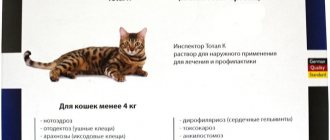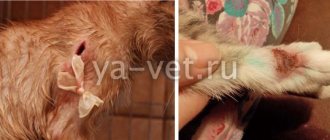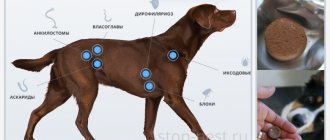The safety of a pet worries every concerned owner, so when choosing a means of protection, many people have a lot of questions: effectiveness, duration, principle of operation, ease of use, etc. And today we propose to consider one of the most popular options for protection against annoying parasites - anti-tick drops for cats on the withers. Today they are used quite actively and have mostly positive reviews.
Why do you need protection against ticks?
In recent years, animal owners have faced an acute problem with the explosive growth of the tick population. And it’s not a matter of tick-borne encephalitis, the carriers of which are not so many among arthropods. A much worse disease is piroplasmosis, the causative agent of which is a protozoan organism from the genus Babesia.
Dogs sometimes suffer from piroplasmosis several times per season. The presence of feline piroplasmosis/babesiosis in Russia is still questionable. This is originally an African disease. But few people would want to be convinced of the presence of the parasite on Russian territory by using their pet as an experimental animal.
On a note!
In addition to babesiosis, ticks carry many other diseases that are dangerous not only for animals, but also for humans.
Ways of infecting a cat with ticks
The risk of being bitten by pets is much lower than that of those who are allowed outside, so Murkosha strongly recommends keeping your pets at home. Otherwise, the risk of contracting infections through parasites and developing diseases of the skin and internal organs increases significantly.
Read more about the dangers of self-walking: Self-walking - when freedom means death
However, domestic cats can also be bitten. Thus, ticks can be brought into the house on your clothes, shoes, or even on another pet if you have a dog. Therefore, you should understand that it is completely impossible to protect a cat, and always pay due attention to the timely treatment of the animal from parasites. We’ll talk more about prevention methods in the last paragraph of this article.
Side effects and contraindications
Adverse reactions when using the drug occur very rarely. Sometimes allergies may occur. In this case, it is enough to wash off the ointment under running warm water and give the cat an antihistamine. The medicine is not used for bacterial and viral infections in animals. The ointment is contraindicated in emaciated cats. The product should not be used during the animal’s recovery period.
The cat has a sore on his withers. Everyone was very scared and upset. The cat belongs to a friend of mine, to whom I suggested that she take her pet to the doctor. She decided to wait a little. As a result, the cat’s body weakened, but the sore began to go away on its own. After some time we decided to try this ointment. However, the doctor said that since the process of recovery has begun, it is best to let the cat get a little stronger and use the product in combination with vitamins. We are pleased with the result. But I do not recommend treating the animal yourself without first consulting a doctor!
Complications
Without timely response and comprehensive treatment, animals affected by subcutaneous mites may experience serious complications, which include the following:
- Entry of unwanted microflora into the body, including various types of fungi, which can provoke the parallel development of other diseases.
- The occurrence of abscesses of hair follicles.
- Disruption of the functioning of the sebaceous glands.
- Necrosis of skin tissue and subsequent decay, as well as the breakdown of products of the inflammatory process.
- Intoxication of the animal's body as a whole.
Which product is better to choose?
The animal owner is faced with the task of protecting the cat not even from the tick itself, but from its bite. To do this, it is necessary that the arthropod cannot even crawl onto the cat. Ticks wait for their prey on the grass. If a cat shakes off a parasite, the tick must try to escape or die quickly. Not all flea and tick products for cats can protect your animal from being bitten.
Mite on a cat
Drops against fleas and ticks on the withers
The action of the drops is based on the fact that the toxic substance is absorbed into the skin and distributed in the upper layer of the epidermis. When using drops, you don’t have to worry that they will be washed away by dew or that your cat will lick them off while washing. But parasites must first bite an animal in order to die. Namely, the bite is dangerous for the cat. The owner will think that he managed to protect the cat from ticks, but in reality the person simply will not see the appearance of the bloodsucker.
Pills
In the understanding of English-speaking specialists, this tool is called this. But it looks like small briquettes. Animals eat them on their own. The most effective remedy if the cat is categorically against treatment. A serious advantage of briquettes is that it is not only a drug against ticks and fleas, but also a cure for worms. After feeding the briquette, the owner simultaneously treats the cat against internal parasites. The tablets are effective for 6 months against fleas and 3 months against ticks.
The disadvantage is the same as in drops on the withers. Briquettes kill ticks, but do not repel them. This means that the tick will bite the cat and only then die.
On a note!
There are concerns that the substances used in drops and briquettes are bad for the liver. The reason for concern is that these drugs penetrate into the body and remain there for a long time. Reviews from veterinarians have not yet confirmed this, but briquettes also appeared relatively recently. Statistics have not yet been collected.
Spray
The anti-tick and flea spray for cats is the same as for dogs. Apply to the fur along the ridge and rub lightly. Once dry, the spray is not harmful to the cat. The smell of the active substance repels parasites. Thanks to this, neither insects nor arthropods will bite the cat. But the spray requires frequent renewal and can be washed off with water. In addition, most cats cannot stand the hiss of the spray and the strong smell. Sprays are made on the basis of esters for maximum drying. An attempt to treat a cat against ticks with a spray often develops into full-fledged combat operations. And the cat comes out the winner.
Anti-tick sprays for cats
Powder
The difference between powder and spray is that the former does not hiss when you shake it onto the fur. But if the animal is suspicious of any manipulation, then even here the treatment of the cat may encounter difficulties in catching and keeping the animal in one place. Otherwise, the principle is similar: the cat is powdered and the powder is rubbed into the fur.
The pros and cons are the same as the spray: the smell of the powder repels parasites, but the powder can be washed off with water. The cat is also able to lick the powder when washing itself.
Collar
The easiest way to protect your cat from ticks in the country. The same substance that is used in other products of a particular brand is “imprinted” into the collar. But the collar is relatively resistant to getting wet. There is no need to bathe the animal with it, but the collar will withstand dew and rain. The cat cannot lick the insecticide off it. The collar lasts longer than powder and spray, but less than briquettes. Considering the lifespan/risk ratio for the pet, the collar is a good way to protect the cat. Putting it on also does not take much time and does not bother your pet.
Types of flea collars
There are four main types of anti-parasitic accessories. They are divided according to the principle of operation and the level of safety.
Biological
Made from rubber. Their main effect is protective; such models cannot cope with the destruction of existing fleas. Essential oils or natural poisons (usually from herbs) are used as impregnation for bio-collars. Such odors are harmless to cats, but perfectly repel ectoparasites. Bio-collars are not dangerous for the cat’s body and are environmentally friendly, although they can sometimes cause allergic reactions (itching, redness, dermatitis), this is due to individual intolerance. The shelf life of biomodels is approximately three months. Recommended for pregnant and lactating cats, as well as for kittens up to one year old.
Insecticidal
They are made from a rubber or polyvinyl chloride base and are impregnated with an antiparasitic composition. The advantages include their real effectiveness, and the disadvantages include the danger of toxic effects on the cat. Before use, it is recommended to stretch the device slightly to activate the active substance. Such products have a protective effect for several months.
Ultrasonic
The fabric base of the cat flea collar is supplemented with a mini-device that emits ultrasound, which is not perceptible to the human ear, but has a depressing effect on insects. It is completely harmless for pets. The mechanism is started by a battery, the performance of which determines the effectiveness of the accessory. Perhaps the only drawback of such devices is the significant price.
Radiating
The mechanism of action of the radiating collar is the propagation of electromagnetic waves, which have a destructive effect on ectoparasites. The advantages of this option include odorlessness and non-toxicity. However, they are not capable of adversely affecting eggs with larvae, and besides, the safety of electromagnetic radiation is a controversial issue.
Regardless of the model type, the listed accessories are suitable for representatives of all breeds: short-haired and long-haired.
Terms of use
So, as we have already said, antiparasitic drops are applied to the animal’s withers. First, you need to take the cat and use a comb or simply use your fingers to push the fur apart in the treated area. We drip the solution onto the body and gently but thoroughly rub it into the skin. After applying the product, the animal should not be bathed for three days.
On a note! Many manufacturers indicate in the instructions that after using the drops, the cat should not be stroked or combed in the treated area!
How much product will be needed for one treatment? This depends on your pet’s age, body weight, health status and other individual characteristics. You will again find information on dosage for each specific case in the instructions.
Safe use
You should work with tick drops with extreme caution and avoid getting them on your mucous membranes. If this does happen, the affected area must be urgently rinsed several times with water.
Some animals may have an individual intolerance to one of the components of the drug, signs of which usually appear during the first two days after use. And if you notice that your pet is behaving somewhat strangely, then it is advisable to seek help from a specialist.
As for licking droplets and the harm from them, they pose a serious threat to health only in high concentrations. This happens when a mother cat has washed her kittens that you have recently treated for ticks. There are already possible negative consequences that will require the intervention of a veterinarian. And to prevent such situations, it is recommended to treat babies only after they have been weaned from their mother.
On a note! And don’t forget that both kittens and adult cats can lick drops from each other’s bodies during play. For the former, this is fraught with serious problems, even death, for the latter – poisoning. Therefore, before you start anti-tick treatment, think about how you can isolate animals from each other!
Intoxication in an adult healthy animal manifests itself in the form of vomiting. Allergies in such animals are extremely rare, but it is still quite possible. As it develops, hair loss, severe itching, and dermatitis may occur.
Active substances
All medications for cats against ticks and fleas are made with different active ingredients. The best option: periodically change brands so that parasites do not get used to the poison. With all the variety of products that protect against ticks and fleas, the range of active ingredients is limited:
- imidacloprid;
- propoxur;
- fipronil;
- fluralaner;
- margosa oil;
- diazinon;
- selamectin;
- tetrachlorvinphos;
- essential oils.
Bayer uses imidacloprid and propoxur. But even with the same active substance (imidacloprid), the duration of action of the product may be different: the Foresto collar “works” for up to 8 months, and Advocate drops only for 1 month. Drops are almost 3 times cheaper, but to protect cats from fleas and ticks it is better to use a collar. It will end up being cheaper. Bayer uses Propoxur in the manufacture of spray.
Anti-tick products for cats
The domestic company Agrovetzaschita uses fipronil in drops on the withers. Drops protect against ticks for 1 month.
Review
I took Bars drops from Agrovetzaschita. Now they are praised even more than popular foreign brands. I was surprised myself, but the drops worked. Before that I used very cheap Butox and Neocidol, but they didn’t work at all. Either they were a fake, or they were just like that.
Alena Tretyakova, Moscow
Drops on the withers for cats from the company Bravecto contain fluralaner. Protection against parasites for 3 months. Compared to Bolfo they lose in price.
On a note!
The Dutch company Bifar produces collars for cats based on a natural substance - margosa oil. The period of protection against ticks (4 months) and low price make this product the best product for cats.
Characteristic
Tick drops are a liquid solution of an insecticide that is active against parasites, but at the same time has low toxicity for the animals themselves. However, if large doses of the drug enter the body, poisoning is possible, and therefore the drops are applied to a place that is inaccessible for licking - on the withers or on the line of the spine. Among the large assortment, you can choose a product for cats of any age, as well as for pregnant and weakened pets.
The active ingredients in anti-tick drops for cats may include:
- permethrin - spreads quite quickly throughout the animal’s body, providing reliable protection, and when it enters the gastrointestinal tract (if the cat does lick off part of the drug), it immediately breaks down without causing any particular harm to health;
- pyriproxyfen - somewhat earlier it was actively used as a filler for anti-parasitic collars, today it has also begun to be used in the manufacture of drops from blood-sucking parasites;
- fipronil is one of the most modern insecticides, which, compared to others, is considered less dangerous for animals;
- Ivermectin is a universal insecticide that works very successfully against a wide range of parasites.
Once on the cat’s body, the active substance spreads over the skin, envelops the hair follicles and after a while begins to gradually evaporate. Toxic vapors penetrate the body and significantly reduce their activity; when bitten, the insecticide almost instantly paralyzes the nervous system, after which the parasite dies.
Peculiarities
- Some drops can only repel bloodsuckers, others can both repel and destroy. You can find this information in the instructions for the drug.
- Many products have a strong odor, which will cause your cat to try to lick them off or wipe them with their paw. To eliminate discomfort and prevent unwanted consequences, after application the product must be thoroughly rubbed into the skin.
- Drops on the withers for the most part work not only against ticks, but also against other blood-sucking parasites: fleas, lice eaters, etc. And after eliminating pests from the animal’s body, they provide good prevention of their reappearance.
- Drops are a very easy-to-use form of protection for pets, and usually one bottle is enough for a complete recovery.
Diagnostics
The process of diagnosing subcutaneous mites in cats is quite complex; it can only be carried out by specialists in laboratory conditions.
Confirmation of the diagnosis is carried out as follows:
- and the contents of the resulting tubercles is performed to make a diagnosis
- Skin particles for analysis are taken by squeezing it on both sides so that the parasites can be squeezed out. Often, several subcutaneous mites can also be found in completely healthy pets. However, if such an amount was recorded in the presence of accompanying symptoms, then a repeat test will be required. Identified parasites are often placed in an artificially created habitat for them in order to be able to observe the process of their reproduction and the development of the created colony.
- The pet's waste products, blood are analyzed, as well as a study of its condition using ultrasound methods. Such diagnostics are necessary to detect possible complications that may be caused by the activity of subcutaneous mites or the accidental entry of secondary microflora into the pet’s body.
For kittens
Most chemical insecticides have a limitation: they cannot be used on very young kittens. Most drugs are intended to be used on kittens older than 2 months. If we are talking about drops, then one pipette is designed for an already adult, albeit medium-sized cat. For a kitten, such a dose will be excessive. But the owner will have to determine the required dosage by eye. It is very difficult to do this at home and in the presence of a squirming kitten.
Important!
You need to be careful when choosing a product for kittens. Especially if in the future these are breeding animals. Chemical insecticides in large quantities can disrupt the reproductive functions of animals.
It is impossible to overdose on preparations containing natural essential oils. And the kitten won't get poisoned either. Therefore, for kittens against fleas and ticks, you can use the following products:
Anti-tick products for kittens
- Bio sport spray from Bifar is based on lavender oil, but the spray provides protection only for a week, then the treatment must be repeated;
- Sentri spray based on clove oil protects against ticks for 2 weeks;
- a Bio Band collar from Bifar with margosa oil may be suitable for a kitten if it can be reduced in length (35 cm for an adult cat), protection against ticks for 4 months;
- drops on the withers from Bifar with margosa extract are made specifically for kittens weighing less than 2 kg; they can successfully replace a collar, but they provide protection for 1 month.
Review
I have been a fan of Bifar since its first appearance in the country. Back then, these products for cats were very expensive. Then they spoiled, I stopped buying. And now the company has entered the market with biosecurity. I really like the smell of lavender. So I buy lavender spray for my cats. And repeating the processing is easy. My cats are calm
Ekaterina Gorodilina, Khimki
What to do if a tick bites a dog or cat
If you notice that a parasite has attached itself to your pet, the bloodsucker must be removed immediately.
It is necessary to take the animal to the nearest veterinary clinic or call a doctor at home in order to properly remove the tick, treat the wound, and immediately submit the parasite for analysis. If this is not done, the bite may result in death.
Tatyana Shmonina, veterinarian, work experience - more than seven years
If it is not possible to take your pet to the doctor, try removing the bloodsucker yourself: the procedure is practically no different from removing a tick from a person.
To do this, you will need a twister, fine-tipped tweezers or thread.
If your dog or cat won't sit still, ask someone to hold it. Otherwise, you risk accidentally crushing the parasite or tearing its body away from its head.
Notoedrosis
The disease is caused by the parasite Notoedres cati. If sarcoptic mange affects any part of the animal’s body, then with notoedrosis the pathological process affects only the neck and head. This is a feature of this disease. Otherwise, the symptoms of notohedrosis are similar to those of sarcoptic mange:
- Excruciating itching appears in the neck and head.
- The animal loses its fur.
- The skin becomes crusty.
- If the disease is advanced, pustules form on the skin.
This disease can also be transmitted to people. However, the mite does not reproduce on human skin, and signs of pathology disappear on their own after about 30 days.
Composition, release form and storage conditions
Aversectin ointment contains aversectin C, which has an effect against parasites. Additionally, the composition includes the following components:
- polyethylene oxide-1500;
- distilled glycerin;
- polyethylene oxide-400.
The ointment has a yellowish tint and a uniform consistency. There should be no foreign inclusions. The product is released only in the form of an ointment, which is placed in a polymer jar. The drug must be stored under certain temperature conditions: from 0 to 20 degrees. Otherwise, the composition will quickly become unusable. The ointment should not be near light sources. The medication should be stored in a dark place for no more than 2 years. After opening the drug, its shelf life is reduced to 24 days.
Aversectin ointment is used in veterinary practice
Attention! The medicine cannot be used after the expiration date. Otherwise, instead of benefit, you can cause harm to the animal.
Pathogen
Otodectes (ear mites) is a parasitic disease caused by the Otodectes cynotis mite. This is a sarcoptiform mite from the family Psoroptidae, its size is quite small - females are 400-500 microns, males up to 395 microns. The parasite looks like a translucent circle or oval with legs; the last pair of legs has long bristles. Parasitizes the external auditory canal of the animal. It has a powerful mouthparts (chelicerae). The life cycle of a tick is about 21-28 days ; in the environment (without a host) it can live up to 25 days .
This is what the causative agent of the disease looks like - the Psoroptes mite, or Psoroptidae Up











